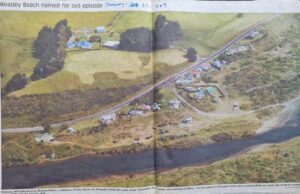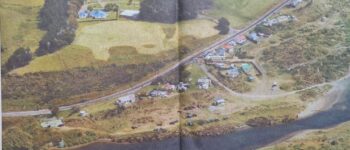1830s: Measley Beach
June 11, 2021
By AHNZ
 As late as 1850 2 or 9 waka and the bones of their Maori crew were still evident at Measley Beach and Wangaloa Creek on the South Otago coast. It may have been a fishing party or a war party but it ended here. More legend than history but the name ‘Measley’ is now attached to the beach also called Waikaro.
As late as 1850 2 or 9 waka and the bones of their Maori crew were still evident at Measley Beach and Wangaloa Creek on the South Otago coast. It may have been a fishing party or a war party but it ended here. More legend than history but the name ‘Measley’ is now attached to the beach also called Waikaro.
Bloody Jack/Chief Tuhawaiki says he was a boy when the disease first came in winter on a ship from Syndey. Many of his people were wiped out, leaving him there to be the new big chief. Born in about 1805, the epidemic, then, got started up in the 1810s. The Measley Beach incident dates from the 1830s with some saying 1834 and others 1838.
“Tuhawaiki succeeded his uncle, Whaka Taupuka, in the mid-1830s after that important chief died with many of his peoplein a measles epidemic.”- NZH (1971)
“About 1838 a couple of war canoes, filled with a war party, landed there, the occupants suffering from measles, a new disease imported by ths Europeans, and very fatal to the Maoris. The party managed to draw up their canoes above high-water mark and camped, making temporary shelter whares. It is reported that every man died, and the remains of their bones and the canoes were seen as late as 1850 by some early European settlers.” – Reminiscences Of The Early Settlement Of Dunedin And South Otago, Wilson (1912)
“There is no evidence that these people who died were a war party… It is possible that the party that was blotted out by measles was the large summer hunting and fishing party from Port Molyneux, who were caught by the white man’s scourge while on their ordinary annual fishing.” – Fred Waite, The Old Time Population of Port Molyneux; Otago Witness (1922); Papers Past
“. . . From Port Cooper to this place two-thirds of the Native women, who are not aged, are living with European men. No wonder, if, in addition to measles, other diseases, and ardent spirits, the aboriginal population is fast diminishing. ” – F. Tuckett, 1844 diary, in T. M. Hocken, documents relating to the purchase of the Otago District etc, Otago Pamphlets 29, p.51; A Report on the Historical Evidence The Ngai Tahu Claim, Ward (1989)
“A considerable number of European men live on the shore of the region, and from the whaling ships that stop, more and more people remain here who like the freedom of this country. All of them amalgamate with the natives and from this a new race is emerging, which will probably devour and fuse with the remainder of the pure natives.”- Wohlers, Ref. AHNZ
Jack’s tribe had other problems too. The 1810s were a time of a bloody Ngai Tahu Civil War. Then, sealers and whalers arrived and the Maori women quit their own society for the more attractive sailors. Then, while all of this was going on, Ngati Toa invaded from the north and left most a wasteland of Ngai Tahu’s former territory. Bloody Jack had his work cut out for him hurrying from place to place to meet Settlers so he could act like he owned the place they wished to settle in order to sell it to them!
These dodgy land deals and the remnants of mixed-race unions are the background history of the South Island Maori today. It’s a good enough story to be worth billions to the right people.
—
Image ref. The Unauthorised History of Kaitangata & South Otago, Facebook
Image ref. RELICS OF A FAST VANISHING RACE: MORIORI SKULLS ON THE NINE-MILE BEACH. CHATHAM ISLANDS, Auckland Weekly News, 1907; Auckland Libraries Heritage Collections
 Like Comment Share
Like Comment Share





